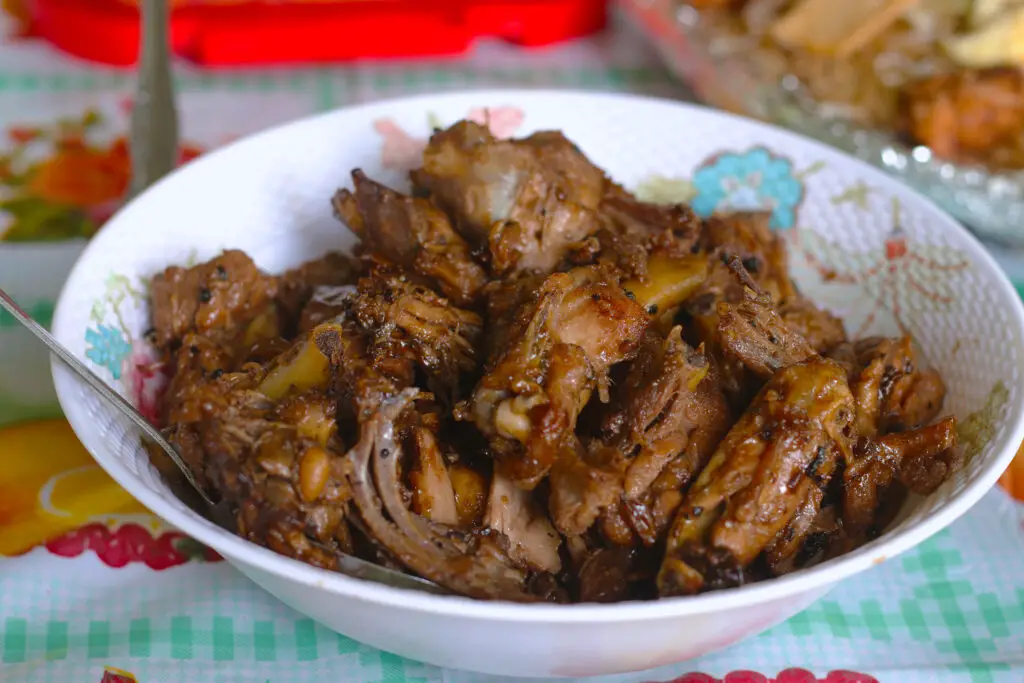Adobo Manok, also known simply as Chicken Adobo, is one of the most beloved and iconic dishes in Filipino cuisine. Its savory, slightly tangy, and sweet flavors encapsulate the essence of Filipino cooking, making it a staple in homes and restaurants throughout the Philippines and beyond. This article delves into the history, cultural significance, and a step-by-step guide to creating this classic dish at home.
Historical and Cultural Background
Adobo Manok’s origins can be traced back to the pre-colonial Philippines, where early Filipinos were already practicing the art of marinating and cooking meat in vinegar and salt to preserve it. When the Spanish colonized the Philippines in the late 16th century, they encountered this cooking method and named it “adobo” after the Spanish word “adobar,” meaning marinade or seasoning. Over the centuries, Filipino Adobo evolved, incorporating ingredients such as soy sauce, brought by Chinese traders, and local spices, creating the rich flavor profile we know today.
The dish’s simplicity, versatility, and robust flavor have made it a symbol of Filipino identity and culinary pride. It represents the melding of indigenous Filipino, Spanish, and Chinese influences, making it a true testament to the Philippines’ rich cultural heritage.
Ingredients
To prepare Adobo Manok, you will need:
1 kg (about 2.2 lbs) chicken, cut into serving pieces
3/4 cup white vinegar
1/4 cup soy sauce
1 cup water
1 head garlic, peeled and crushed
1 teaspoon black peppercorns
3-5 bay leaves
2 tablespoons cooking oil
1 tablespoon sugar (optional)
Salt to taste
Instructions
Marinate the Chicken: In a large bowl, combine the chicken, vinegar, soy sauce, half of the crushed garlic, peppercorns, and bay leaves. Mix well and let it marinate for at least 1 hour or overnight in the refrigerator for better absorption of flavors.
Sauté the Garlic: Heat the oil in a large skillet or pot over medium heat. Add the remaining crushed garlic and sauté until it’s golden brown, being careful not to burn it.
Brown the Chicken: Add the marinated chicken pieces to the skillet, reserving the marinade. Cook until each side is lightly browned.
Simmer: Pour the reserved marinade and water into the skillet. Bring to a boil, then reduce the heat to low. Cover and simmer for about 30 minutes or until the chicken is tender.
Add Sugar and Season: If using, add the sugar to balance the acidity. Season with salt to taste.
Increase the heat to medium and continue to cook the adobo uncovered, allowing the sauce to reduce and thicken to your desired consistency.
Serve: Serve your Adobo Manok hot with steamed rice. Enjoy the complex flavors of this beloved Filipino dish.
Variations
The beauty of Adobo Manok lies in its adaptability. Regional variations abound throughout the Philippines, with some adding coconut milk for a richer sauce or pineapple chunks for a hint of sweetness. Others prefer a “dry” adobo, where the dish is cooked until almost all the liquid evaporates, leaving the chicken coated in a thick, flavorful glaze.
Adobo Manok’s enduring popularity is a testament to its rich history, cultural significance, and delicious taste. It’s more than just a dish; it’s a celebration of Filipino heritage and culinary tradition. By following this recipe, you can bring a taste of the Philippines to your table and experience the comforting flavors that have made Adobo a beloved dish around the world.
Beyond its delicious taste and comforting qualities, Adobo Manok serves as a culinary bridge, connecting Filipinos across the globe to their cultural roots. Each family’s recipe is a testament to their history, passed down through generations, each with its unique twist on the classic dish. This variability ensures that no two Adobo are exactly alike, yet each is unmistakably part of the rich tapestry of Filipino cuisine.
Tips for Perfecting Your Adobo Manok
Marination Time: The longer you marinate the chicken, the deeper the flavors will penetrate.
Overnight marination is recommended for optimal taste.
Quality of Ingredients: Using high-quality soy sauce and vinegar can significantly affect the flavor of your Adobo. Traditional Filipino brands or artisanal soy sauces and natural vinegars offer a more authentic taste.
Balancing Flavors: The key to a great Adobo lies in the balance between acidity, saltiness, and sweetness. Adjust the amounts of vinegar, soy sauce, and sugar to suit your palate. Some prefer a tangier taste, while others lean towards a sweeter or saltier finish.
Cooking Technique: Allowing the sauce to reduce and thicken not only concentrates the flavors but also coats the chicken beautifully. For a drier Adobo, continue cooking until the sauce is almost fully evaporated.
Serving Suggestions
Adobo Manok is traditionally served with steamed white rice, which perfectly complements its bold flavors. For a complete meal, it can be paired with a simple vegetable side dish, such as stir-fried greens or a fresh salad. The dish is also versatile enough to be served in various other ways, including over noodles or shredded as a filling for tacos or sandwiches, showcasing its ability to transcend traditional Filipino cuisine and blend into other culinary traditions.
Adobo Manok is more than just a recipe; it’s a cultural icon that embodies the history, diversity, and resilience of the Filipino people. Its simple ingredients and cooking method belie the depth of its flavors and the warmth it brings to those who enjoy it. Whether you’re a seasoned cook or new to Filipino cuisine, making Adobo Manok is a rewarding experience that connects you to the rich culinary heritage of the Philippines. So, gather your ingredients, and let the comforting aroma of cooking Adobo fill your kitchen and your heart.
Frequently Asked Questions (FAQ) about Adobo Manok
Can I use boneless chicken for Adobo Manok?
Yes, you can use boneless chicken pieces for Adobo Manok. While traditional recipes often use bone-in chicken for added flavor, boneless chicken will cook faster and can be more convenient for some. Adjust cooking times accordingly, as boneless chicken tends to cook through quicker.
Is it necessary to marinate the chicken overnight?
While marinating the chicken overnight enhances the depth of flavor, if you’re short on time, even an hour of marination can impart a good taste to the dish. The key is to ensure the chicken is well-coated and allowed to absorb the marinade for as long as possible.
Can I make Adobo Manok without soy sauce?
Yes, Adobo can be made without soy sauce, reverting to what is sometimes referred to as “Adobong Puti.” This version uses only vinegar, garlic, bay leaves, and peppercorns, offering a different flavor profile that is tangier and highlights the vinegar’s sharpness.
How can I make my Adobo sauce thicker?
To thicken the sauce, allow the dish to simmer uncovered after the chicken is tender. The liquid will reduce, concentrating the flavors and naturally thickening the sauce. For an even thicker sauce, you can remove the chicken once cooked, and continue to reduce the sauce to the desired consistency before adding the chicken back in to coat it thoroughly.
Is Adobo Manok suitable for freezing?
Yes, Adobo Manok freezes very well. The flavors can even improve after being frozen, as this allows more time for the chicken to absorb the marinade. Make sure to cool the Adobo completely before transferring it to airtight containers. It can be frozen for up to 3 months. Thaw in the refrigerator overnight before reheating.
Can I use other meats or proteins in Adobo?
Absolutely! While chicken is traditional for Adobo Manok, the adobo preparation is incredibly versatile and can be applied to pork (Adobong Baboy), beef, seafood, or even vegetables and tofu for a vegetarian version. Each type of meat or alternative protein offers a unique twist on the classic dish.
How can I adjust the Adobo recipe to make it less salty or tangy?
If you find the Adobo too salty, you can reduce the amount of soy sauce and substitute part of it with water or a low-sodium broth. For less tanginess, decrease the amount of vinegar slightly or add a bit more sugar to balance the acidity. Remember, the beauty of Adobo lies in its adaptability to your taste preferences.
What is the best way to reheat Adobo Manok?
The best way to reheat Adobo Manok is slowly, on a stovetop, over low heat to ensure the chicken doesn’t dry out. Adding a little water or broth can help prevent the sauce from burning and keep the chicken moist. Microwave reheating is also an option, but be sure to cover the dish and use a lower power setting to avoid drying out the meat.
Adobo Manok’s versatility, ease of preparation, and heartwarming flavors make it a cherished dish among Filipinos and food lovers worldwide. Whether you’re cooking it for the first time or the hundredth, its rich history and the joy it brings to the table make it a rewarding dish to master and share.




